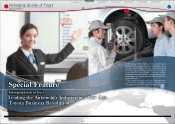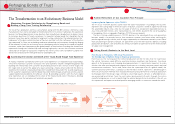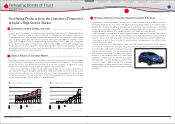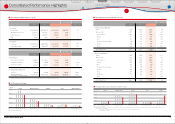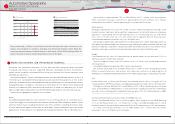Toyota 2010 Annual Report Download - page 16
Download and view the complete annual report
Please find page 16 of the 2010 Toyota annual report below. You can navigate through the pages in the report by either clicking on the pages listed below, or by using the keyword search tool below to find specific information within the annual report.
TOYOTA ANNUAL REPORT 2010 14
In consideration of the various issues faced during the past year, Toyota’s growth
strategy for the continued realization of
Genchi Genbutsu
and high quality at
affordable prices will center on a thorough customer-first perspective. Specifically,
we will review our product lineups to match customer needs in each region and
create a production system that responds to changes in market structure while
optimally allocating resources in areas where we want to advance.
Restoring Our Profit Base: Production Restructuring Plan
Accelerating Growth: Support for Developing Nations and
Next-Generation Eco-Cars
While proactively investing in growth areas, we will strive to realize a muscular profit
structure that is relatively impervious to changes in the business environment. While
increasing local production in emerging markets such as China and India, in developed
countries with mature markets, including Japan, North America and Europe, we will review
production models in response to changes in the market structure and create a flexible
and efficient production system that is resistant to exchange rate fluctuations to realize an
optimal global supply system with clearly positioned strategies in each region.
To accelerate growth, we are placing a priority on business in developing nations and on
next-generation eco-cars.
First, with regard to developing nations, we will promote the expansion of product
lineups primarily in China and India, as well as the development of a production system.
In fast-growing China, a new plant was built in Changchun to further expand production
capacity in response to local demand, with operation scheduled to commence in the first
half of 2012. To expand Toyota’s product lineup, we have begun local production of the
Camry hybrid, following the Prius. Furthermore, in the Indian market, the newly developed
Etios compact car, designed to thoroughly meet the needs of local drivers, is scheduled to
go on sale at the end of this year.
Second, with regard to our priority focus on next-generation eco-cars, we plan on raising
the level of hybrid technology and expanding models. As for plug-in hybrid vehicles (PHVs),
we have begun aggressive efforts toward a 2012 sales launch. In terms of electric vehicles
(EVs), in May we announced a business partnership with Silicon Valley EV venture Tesla
Motors with the aim of strengthening our next-generation eco-car development structure.
Region
Strategic Positioning Production System Reviews
North
America
An important base in
terms of volume and
profitability
Promote self-reliance from development to pre-production to
production in an attempt to revamp the production structure, taking into
consideration local demand trends and the future of hybrid and compact
vehicles.
Europe
A market for further
improved technology
Engage in the building of appealing vehicles and consider production
structure while monitoring product trends.
Japan
A base for developing
models, providing
assistance to our
overseas operations
and for building
vehicles for export
Taking external environment into account, broadly review our current
production structure.
・Thorough review of domestic production model
Conduct mass production of export vehicles in regions where demand
exists, and produce models focusing on new technologies, new
concepts and new manufacturing methods.
・Create a flexible and efficient production structure that can
respond to changes in demand
Create a production structure centered on the same types of
platform, including the introduction of mixed production lines.
・“Stop and Consolidate” domestic production facilities
Maintain current production levels by evening out plant and line
utilization rates to increase efficiency.
Future Growth Strategy in Consideration of Issues
during the Past Year
Financial Services Operations
Other Business Operations Motorsports Activities
Financial Section
Investor Information
Corporate Information
Business Overview
Special Feature
Top Messages
Consolidated
Performance Highlights
Automotive Operations
Automotive Operations
Business Overview
(Market Environment and Overview)




